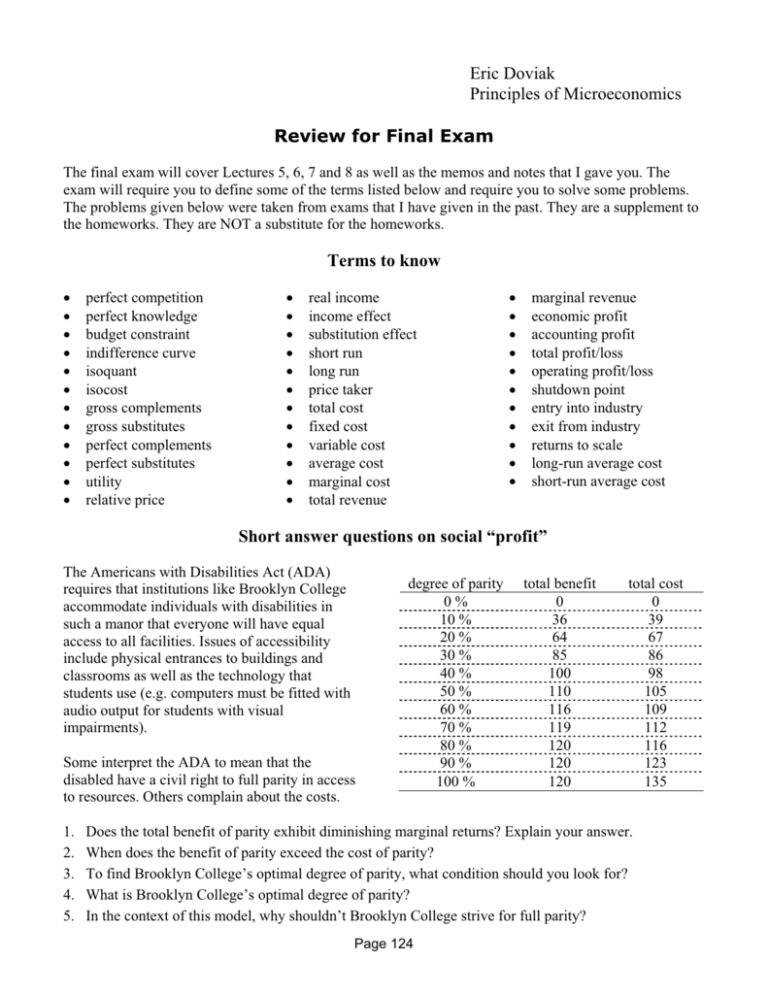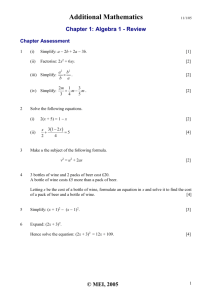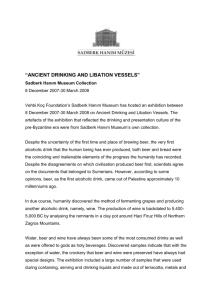Eric Doviak Principles of Microeconomics Review for Final Exam
advertisement

Eric Doviak Principles of Microeconomics Review for Final Exam The final exam will cover Lectures 5, 6, 7 and 8 as well as the memos and notes that I gave you. The exam will require you to define some of the terms listed below and require you to solve some problems. The problems given below were taken from exams that I have given in the past. They are a supplement to the homeworks. They are NOT a substitute for the homeworks. Terms to know x x x x x x x x x x x x perfect competition perfect knowledge budget constraint indifference curve isoquant isocost gross complements gross substitutes perfect complements perfect substitutes utility relative price x x x x x x x x x x x x real income income effect substitution effect short run long run price taker total cost fixed cost variable cost average cost marginal cost total revenue x x x x x x x x x x x marginal revenue economic profit accounting profit total profit/loss operating profit/loss shutdown point entry into industry exit from industry returns to scale long-run average cost short-run average cost Short answer questions on social “profit” The Americans with Disabilities Act (ADA) requires that institutions like Brooklyn College accommodate individuals with disabilities in such a manor that everyone will have equal access to all facilities. Issues of accessibility include physical entrances to buildings and classrooms as well as the technology that students use (e.g. computers must be fitted with audio output for students with visual impairments). Some interpret the ADA to mean that the disabled have a civil right to full parity in access to resources. Others complain about the costs. 1. 2. 3. 4. 5. degree of parity 0% 10 % 20 % 30 % 40 % 50 % 60 % 70 % 80 % 90 % 100 % total benefit 0 36 64 85 100 110 116 119 120 120 120 total cost 0 39 67 86 98 105 109 112 116 123 135 Does the total benefit of parity exhibit diminishing marginal returns? Explain your answer. When does the benefit of parity exceed the cost of parity? To find Brooklyn College’s optimal degree of parity, what condition should you look for? What is Brooklyn College’s optimal degree of parity? In the context of this model, why shouldn’t Brooklyn College strive for full parity? Page 124 Short answer questions on household behavior and consumer choice The scenarios below describe how my consumption of beer and wine changes when my income changes and/or when the price of one or both goods changes. For each scenario, say whether my consumption is affected by: x an income effect, x a substitution effect, x a combined income and substitution effect x or no effect. and explain why! Each scenario is independent of the previous ones and independent of successive ones. In each scenario, I initially consume 50 beers and 50 wines. My initial income is $200. The initial price of beer is $2 and the initial price of wine is $2. 1. The price of wine falls to $1. The price of beer rises to $3. I increase my consumption of wine to 80 wines and decrease my consumption of beer to 40 beers. 2. The price of beer and the price of wine both increase to $4. My income rises to $400. I continue to consume 50 beers and 50 wines. 3. The price of beer and the price of wine both rise to $4. I decrease my consumption to 25 beers and 25 wines. 4. The price of wine falls to $1. I increase my consumption of wine to 150 wines and decrease my consumption of beer to 25 beers. Demand Curves for Beer and Wine For the scenario above where my consumption of beer and wine is affected by a combined income and substitution effect: 5. Draw the initial budget constraint and indifference curve. Place beer on the vertical axis and wine on the horizontal axis. 6. Draw the substitution effect. Be sure to LABEL that substitution effect. 7. Draw the income effect. Be sure to LABEL that income effect. 8. Is wine a gross substitute for beer? OR is wine a gross complement to beer? 9. Draw the demand curve for beer and the demand curve for wine. If a demand curve shifts, then illustrate that shift. If there is movement along a demand curve, then illustrate that movement. ƇƇƇ Short answer questions on profit-maximization and elasticity A firm in perfect competition faces a perfectly elastic demand for its product (i.e. they are price takers). In reality however, firms usually have some ability to set the price of their product. x What assumptions lead to the result that firms face perfectly elastic demand? x How might real life firm make the demand for its product less elastic? x How would a firm benefit from having a less elastic demand curve? (continued on the next page) Page 125 Short answer questions on perfect competition x x Economists often talk about firms that operate in a perfectly competitive industry. Describe the three characteristics of a perfectly competitive industry. Discuss the three reasons why economists assume that firms in a perfectly competitive industry make zero profit in the long run. ƇƇƇ Short answer questions on profit-maximization You are given the following data on a profitmaximizing firm’s production in the short-run (its capital stock is fixed). The quantity of output that it produces (Q) depends on the amount of capital (K) and labor (L) it employs. The firm must pay rent on its capital stock at a rate of about $2 per unit, so its total rent bill is $1000. Q K L MPL 309.02 500 73 -- 310.08 500 74 311.13 500 75 312.17 500 76 313.20 500 77 314.22 500 78 315.23 500 79 It also must pay a wage rate of $5 per unit of labor. 316.23 500 80 Calculate the marginal product of labor for each output level. (NB: the marginal product of labor is the change in output per unit change in labor). 317.22 500 81 318.20 500 82 Up until what point does a profit-maximizing firm hire labor? (Hint: the answer is in Lecture 6) If the firm can sell all of its output on a perfectly competitive market at a price of $5 per unit, then how much should it produce? How many units of labor should it employ? Using your answers to the previous two questions, what will the firm’s profit be? Could it maintain this profit in the long-run? Why or why not? Page 126








